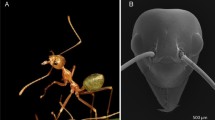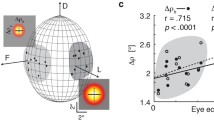Summary
The pupil mechanism of Hymenoptera (suborder Apocrita) has been studied by simultaneous recordings of transmission and reflection from the compound eye of virtually intact animals. It is confirmed that the light flux in the photoreceptors is controlled by pigment granules in the retinula cells; the pigment migration serves a pupil function. Experimental methods are described for investigation of the pupil process using only reflection measurements. Using polarised light, it is found that backscattered light from the rhabdom is more strongly depolarised than light backscattered from retinula cell pigment granules.
The dynamic characteristics of the pigment migration are determined more accurately than could be done previously with histological methods (Menzel, 1972a, b; Kolb and Autrum, 1972, 1974). The hymenopteran pupil mechanism has a familiar sigmoid intensity dependence; the time constant is 5–15 s. The pupil absorbance spectrum is broad, peaking at about 520 nm. The correspondence of this spectrum with known spectral sensitivities exemplifies that the pupil mechanism is a useful part of the visual system.
Similar content being viewed by others
References
Autrum, H., Zwehl, V. von: Spektrale Empfindlichkeit einzelner Sehzellen des Bienenauges. Z. vergl. Physiol.48, 357–384 (1964)
Brunnert, A., Wehner, R.: Fine structure of light- and dark adapted eyes of desert ants,Cataglyphis bicolor (Formicidae, Hymenoptera). J. Morph.140, 15–30 (1973)
Butler, R.: The identification and mapping of spectral cell types in the retina ofPeriplaneta americana. Z. vergl. Physiol.72, 67–80 (1971)
Exner, S.: Die Physiologie der facettirten Augen von Krebsen und Insekten. Leipzig und Wien: Franz Deuticke 1891
Franceschini, N.: Sur le traitement optique de l'information visuelle dans l'oeil à facettes de la drosophile. Thesis, Grenoble (1972a)
Franceschini, N.: Pupil and pseudopupil in the compound eye ofDrosophila. In: Information processing in the visual systems of arthropods (Wehner, R., ed.), pp. 75–82. Berlin-Heidelberg-New York: Springer 1972b
Franceschini, N.: Sampling of the visual environment by the compound eye of the fly: Fundamentals and applications. In: Photoreceptor optics (A.W. Snyder and R. Menzel, eds.), pp. 98–125. Berlin-Heidelberg-New York: Springer 1975
Franceschini, N., Kirschfeld, K.: Etude optique in vivo des éléments photorécepteurs dans l'oeil composé deDrosophila. Kybernetik8, 1–13 (1971a)
Franceschini, N., Kirschfeld, K.: Les phénomènes de pseudo-pupille dans l'oeil composé deDrosophila. Kybernetik9, 159–182 (1971b)
Franceschini, N., Kirschfeld, K.: Le contrôle automatique du flux lumineux dans l'oeil composé des Diptères. Propriétés spectrales, statiques et dynamiques du mécanisme. Biol. Cybernetics21, 181–203 (1976)
Goldsmith, T.H., Bernard, G.D.: The visual system of insects. In: The physiology of insecta. 2 Ed. (Rockstein, M., ed.), Vol. II, pp. 165–272. New York: Academic Press 1974
Gribakin, F.G.: The distribution of the long wave photoreceptors in the compound eye of the honeybee as revealed by selective osmic staining. Vision Res.12, 1225–1230 (1972)
Gribakin, F.G.: Functional morphology of the compound eye of the bee. In: The compound eye and vision of insects (G.A. Horridge, ed.), pp. 154–176. Oxford: Clarendon Press 1975
Höglund, G., Langer, H., Struwe, G., Thorell, B.: Spectral absorption by screening pigment granules in the compound eyes of a moth and a wasp. Z. vergl. Physiol.67, 238–242 (1970)
Kirschfeld, K.: Projektion der optischen Umwelt auf das Raster der Rhabdomere im Komplexauge vonMusca. Exp. Brain Res.3, 248–270 (1967)
Kirschfeld, K.: Absorption properties of photopigments in single rods, cones and rhabdomeres. In: Processing of optical data by organisms and machines (Reichardt, W., ed.), pp. 116–136. New York-London: Academic Press 1969
Kirschfeld, K.: Optomotorische Reaktionen der Biene auf bewegte „Polarisations-Muster“. Z. Naturforsch.28c, 329–338 (1973)
Kirschfeld, K., Franceschini, N.: Optische Eigenschaften der Ommatidien im Komplexauge vonMusca. Kybernetik5, 47–52 (1968)
Kirschfeld, K., Franceschini, N.: Ein Mechanismus zur Steuerung des Lichtflusses in den Rhabdomeren des Komplexauges vonMusca. Kybernetik6, 13–22 (1969)
Kolb, G., Autrum, H.: Die Feinstruktur im Auge der Biene bei Hell- und Dunkeladaptation. J. comp. Physiol.77, 113–125 (1972)
Kolb, G., Autrum, H.: Selektive Adaptation und Pigmentwanderung in den Sehzellen des Bienenauges. J. comp. Physiol.94, 1–6 (1974)
Kuiper, J.W.: The optics of the compound eye. In: Biological receptor mechanisms (J.W.L. Beament, ed.), pp. 58–71. London: Cambridge University Press 1962
Langer, H.: Properties and functions of screening pigments in insect eyes. In: Photoreceptor optics (A.W. Snyder, R. Menzel, eds.), pp. 429–455. Berlin-Heidelberg-New York: Springer 1975
Mazokhin-Porshnyakow, G.A.: Insect vision. New York: Plenum Press 1969
Menzel, R.: Über den Farbensinn von Paravespula germanica F. (Hymenoptera): ERG und selektive Adaptation. Z. vergl. Physiol.75, 86–104 (1971)
Menzel, R.: Feinstruktur des Komplexauges der Roten WaldameiseFormica polyctena (Hymenoptera, Formicidae). Z. Zellforsch.127, 356–373 (1972a)
Menzel, R.: The fine structure of the compound eye ofFormica polyctena — Functional morphology of a hymenopteran eye. In: Information processing in the visual systems of arthropods (R. Wehner, ed.), pp. 37–47. Berlin-Heidelberg-New York: Springer 1972b
Menzel, R., Lange, G.: Änderungen der Feinstruktur im Komplexauge vonFormica polyctena bei der Helladaptation. Z. Naturforsch.26b, 357–359 (1971)
Menzel, R., Knaut, R.: Pigment movement during light and chromatic adaptation in the retinula cells ofFormica polyctena (Hymenoptera, Formicidae). J. comp. Physiol.86, 125–138 (1973)
Perrelet, A.: The fine structure of the honeybee drone. An electron microscopical study. Z. Zellforsch.108, 530–562 (1970)
Snyder, A.W.: Optical properties of invertebrate photoreceptors. In: The compound eye and vision of insects (G.A. Horridge, ed.), pp. 179–235. Oxford: Clarendon Press 1975
Snyder, A.W., Horridge, G.A.: The optical function of changes in the medium surrounding the cockroach rhabdom. J. comp. Physiol.81, 1–8 (1972)
Snyder, A.W., Menzel, R. (eds.): Photoreceptor optics. Berlin-Heidelberg-New York: Springer 1975
Stavenga, D.G.: Adaptation in the compound eye. Proc. Int. Union Physiol. Sc. IX. 532. XXV Int. Congr. Munich (1971)
Stavenga, D.G.: Waveguide modes and refractive index in photoreceptors of invertebrates. Vision Res.15, 323–330 (1975a)
Stavenga, D.G.: Optical qualities of the fly eye — An approach from the side of geometrical, physical and waveguide optics. In: Photoreceptor optics (A.W. Snyder, R. Menzel, eds.), pp. 126–144. Berlin-Heidelberg-New York: Springer 1975b
Stavenga, D.G.: Visual adaptation in butterflies. Nature (Lond.)254, 435–437 (1975c)
Stavenga, D.G., Zantema, A., Kuiper, J.W.: Rhodopsin processes and the function of the pupil mechanism in flies. In: Biochemistry and physiology of visual pigments (H. Langer, ed.), pp. 175–180. Berlin-Heidelberg-New York: Springer 1973
Stavenga, D.G., Flokstra, J.H., Kuiper, J.W.: Photopigment conversions expressed in pupil mechanism of blowfly visual sense cells. Nature (Lond.)253, 740–742 (1975)
Stavenga, D.G., Numan, J.A.J., Tinbergen, J., Kuiper, J.W.: Insect pupil mechanisms. II. Pigment migration in retinula cells of butterflies. J. comp. Physiol.113, 73–93 (1977)
Strother, G.K., Casella, A.J.: Microspectrophotometry of arthropod visual screening pigments. J. gen. Physiol.59, 616–636 (1972)
Varela, F.G., Wiitanen, W.: The optics of the compound eye of the honeybee (Apis mellifera). J. gen. Physiol.55, 336–358 (1970)
Vishnevskaya, T.M., Mazokhin-Porshnyakov, G.A.: Spectral sensitivity of single visual cells of the grasshopperTettigonia cantans and the bumblebeeBombus distinguendus. Biophysics17, 635–641 (1972)
Vries, H.L. de: Physical aspects of the sense organs. Progr. Bioph.6, 208–264 (1956)
Walcott, B.: Anatomical changes during light adaptation in insect compound eyes. In: The compound eye and vision of insects (Horridge, G.A., ed.), pp. 20–33. Oxford: Clarendon Press 1975
Author information
Authors and Affiliations
Additional information
We thank Drs. J.T. Leutscher-Hazelhoff and S.B. Laughlin, and R.C. Hardie for their valuable criticism on the manuscript.
Rights and permissions
About this article
Cite this article
Stavenga, D.G., Kuiper, J.W. Insect pupil mechanisms. J. Comp. Physiol. 113, 55–72 (1977). https://doi.org/10.1007/BF00610453
Received:
Issue Date:
DOI: https://doi.org/10.1007/BF00610453




